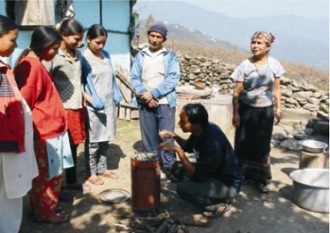Clean stoves, health & climate
Indoor air pollution is a major challenge in India. About half of all households use wood as their primary fuel source for cooking. At least 80% of rural households use biomass fuel. Inefficient burning of such fuels leads to high levels of health-damaging air pollutants like particulate matter, carbon monoxide and hydrocarbons in many Indian homes.
These high levels of indoor air pollution are associated with many negative health effects. In fact, India has among the world’s largest burdens of disease due to household fuels. It is estimated that 28% of all deaths due to indoor air pollution in developing countries occur in India. Additionally, biomass contributes to 3.5% of morbidity and mortality, 400,000 deaths in children due to acute lower respiratory tract infections, COPD in women, and lung cancer (primarily in women). Respiratory infections and other respiratory diseases—acute lower respiratory tract infections, TB and chronic obstructive pulmonary disease—are the 3rd and 7th highest causes of disease burden in terms of disability adjusted life years, accounting for about 15% of the total disease burden in India.
While we have these general figures for the burden of disease from indoor smoke in India, there is currently no means of directly quantifying the health benefits of reducing exposure to indoor air pollution. However, several ongoing activities in India are expected to make major contributions in this area.
Kalpana Balakrishnan of the Environmental Health Engineering Department of Sri Ramachandra University (SRU) in Chennai will soon be launching a longitudinal environmental health study to examine relationships between air pollution and select health outcomes. The study will recruit pregnant women from both rural and urban communities and follow the mother-child pairs over a period of 2-3 years. This study will allow the establishment of relationships between exposures to indoor and outdoor air pollutants and select adverse pregnancy and early childhood health outcomes. This would then help develop exposure-response relationships for several health outcomes. Researchers increasingly suspect that indoor air pollution contributes to low birth weight, cleft palate, and possibly even cognitive impairment.
Another exciting new development in India is Project Surya led by V Ramanathan of the Scripps Institution of Oceanography at the University of California San Diego. This project was launched in March 2009 in Uttar Pradesh. Currently in the pilot phase, the project will distribute a range of cleaner cooking technologies including solar and improved biomass cookers to villagers. The project team will then undertake an unprecedented effort to document the effects of these changes on global and regional climate change through reductions in atmospheric concentrations of black carbon, ozone-producing gases, and methane emissions from cooking fires, and by curtailing increases in CO2 from avoided deforestation, as well as documenting more direct effects of the new technologies on human health.
Additionally, Berkeley Air Monitoring Group, partnered with SRU, is currently carrying out the initial stages of a field-based impact assessment for the Shell Foundation’s Breathing Space Programme. In keeping with the programme’s current focus on developing appropriate products, the monitoring is designed to assess the efficacy of various improved biomass in reducing air pollution in homes.
Recent results show significant reductions in particulate matter and carbon monoxide concentrations and fuel savings. As the technologies are refined, there are plans to expand to additional impacts over the next year. These will include measurement of fuel savings to calculate reductions in carbon emissions and quantification of socioeconomic and health benefits in homes with improved stoves. Ultimately, as sales of improved stoves grow towards the 10 million stove goal, the focus of the programme evaluation will shift towards tracking the population-level impacts of the Breathing Space Programme, including estimating its effect on public health.
Over the next five years, these initiatives are expected to make major contributions to our understanding of the link between indoor air pollution, health and climate, especially in India. These advances will allow better quantification of the health benefits of reductions in indoor air pollution through improved understanding of the dose-response relationship between pollutant exposure and specific health outcomes. We will also have enhanced information on the contribution of cook stoves to global warming (via emissions of black carbon and greenhouse gases) and on the direct socioeconomic and health benefits experienced by people at the household level.
Together, these advances in understanding should help solidify the case for the many benefits of improved cook stoves.
Source – http://www.financialexpress.com/news/clean-stoves-health-&-climate/508074/#




{ 1 comment… read it below or add one }
This is a very interesting article. We do not think of women has being affected by poor indoor air quality at home. And yet, it is very important that clean stoves be made available to reduce indoor pollutants. It is the only way to protect women health as well as unborn and live children.